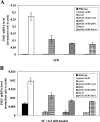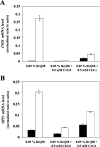Transcriptional regulation of phospholipid biosynthesis is linked to fatty acid metabolism by an acyl-CoA-binding-protein-dependent mechanism in Saccharomyces cerevisiae
- PMID: 17593018
- PMCID: PMC2049021
- DOI: 10.1042/BJ20070315
Transcriptional regulation of phospholipid biosynthesis is linked to fatty acid metabolism by an acyl-CoA-binding-protein-dependent mechanism in Saccharomyces cerevisiae
Abstract
In the present study, we have used DNA microarray and quantitative real-time PCR analysis to examine the transcriptional changes that occur in response to cellular depletion of the yeast acyl-CoA-binding protein, Acb1p. Depletion of Acb1p resulted in the differential expression of genes encoding proteins involved in fatty acid and phospholipid synthesis (e.g. FAS1, FAS2, ACC1, OLE1, INO1 and OPI3), glycolysis and glycerol metabolism (e.g. GPD1 and TDH1), ion transport and uptake (e.g. ITR1 and HNM1) and stress response (e.g. HSP12, DDR2 and CTT1). In the present study, we show that transcription of the INO1 gene, which encodes inositol-3-phosphate synthase, cannot be fully repressed by inositol and choline, and UAS(INO1) (inositol-sensitive upstream activating sequence)-driven transcription is enhanced in Acb1p-depleted cells. In addition, the reduction in inositol-mediated repression of INO1 transcription observed after depletion of Acb1p appeared to be independent of the transcriptional repressor, Opi1p. We also demonstrated that INO1 and OPI3 expression can be normalized in Acb1p-depleted cells by the addition of high concentrations of exogenous fatty acids, or by the overexpression of FAS1 or ACC1. Together, these findings revealed an Acb1p-dependent connection between fatty acid metabolism and transcriptional regulation of phospholipid biosynthesis in yeast. Finally, expression of an Acb1p mutant which is unable to bind acyl-CoA esters could not normalize the transcriptional changes caused by Acb1p depletion. This strongly implied that gene expression is modulated either by the Acb1p-acyl-CoA ester complex directly or by its ability to donate acyl-CoA esters to utilizing systems.
Figures







Similar articles
-
Inhibition of acetyl coenzyme A carboxylase activity restores expression of the INO1 gene in a snf1 mutant strain of Saccharomyces cerevisiae.Mol Cell Biol. 2001 Sep;21(17):5710-22. doi: 10.1128/MCB.21.17.5710-5722.2001. Mol Cell Biol. 2001. PMID: 11486011 Free PMC article.
-
Depletion of acyl-coenzyme A-binding protein affects sphingolipid synthesis and causes vesicle accumulation and membrane defects in Saccharomyces cerevisiae.Mol Biol Cell. 2001 Apr;12(4):1147-60. doi: 10.1091/mbc.12.4.1147. Mol Biol Cell. 2001. PMID: 11294913 Free PMC article.
-
NuA4 Lysine Acetyltransferase Complex Contributes to Phospholipid Homeostasis in Saccharomyces cerevisiae.G3 (Bethesda). 2017 Jun 7;7(6):1799-1809. doi: 10.1534/g3.117.041053. G3 (Bethesda). 2017. PMID: 28455416 Free PMC article.
-
Long-chain acyl-CoA-dependent regulation of gene expression in bacteria, yeast and mammals.J Nutr. 2000 Feb;130(2S Suppl):305S-309S. doi: 10.1093/jn/130.2.305S. J Nutr. 2000. PMID: 10721893 Review.
-
Yeast acyl-CoA synthetases at the crossroads of fatty acid metabolism and regulation.Biochim Biophys Acta. 2007 Mar;1771(3):286-98. doi: 10.1016/j.bbalip.2006.05.003. Epub 2006 May 16. Biochim Biophys Acta. 2007. PMID: 16798075 Review.
Cited by
-
Engineering Ashbya gossypii for efficient biolipid production.Bioengineered. 2015;6(2):119-23. doi: 10.1080/21655979.2015.1011525. Bioengineered. 2015. PMID: 25625436 Free PMC article.
-
Overexpression of the Arabidopsis 10-kilodalton acyl-coenzyme A-binding protein ACBP6 enhances freezing tolerance.Plant Physiol. 2008 Sep;148(1):304-15. doi: 10.1104/pp.108.123331. Epub 2008 Jul 11. Plant Physiol. 2008. PMID: 18621979 Free PMC article.
-
Cardiolipin molecular species with shorter acyl chains accumulate in Saccharomyces cerevisiae mutants lacking the acyl coenzyme A-binding protein Acb1p: new insights into acyl chain remodeling of cardiolipin.J Biol Chem. 2009 Oct 2;284(40):27609-19. doi: 10.1074/jbc.M109.016311. Epub 2009 Aug 5. J Biol Chem. 2009. PMID: 19656950 Free PMC article.
-
HIF-1-dependent regulation of lifespan in Caenorhabditis elegans by the acyl-CoA-binding protein MAA-1.Aging (Albany NY). 2017 Jul 27;9(7):1745-1769. doi: 10.18632/aging.101267. Aging (Albany NY). 2017. PMID: 28758895 Free PMC article.
-
Plant Acyl-CoA-Binding Proteins-Their Lipid and Protein Interactors in Abiotic and Biotic Stresses.Cells. 2021 Apr 30;10(5):1064. doi: 10.3390/cells10051064. Cells. 2021. PMID: 33946260 Free PMC article. Review.
References
-
- Baumgartner U., Hamilton B., Piskacek M., Ruis H., Rottensteiner H. Functional analysis of the Zn2Cys6 transcription factors Oaf1p and Pip2p. Different roles in fatty acid induction of β-oxidation in Saccharomyces cerevisiae. J. Biol. Chem. 1999;274:22208–22216. - PubMed
-
- Choi J. Y., Martin C. E. The Saccharomyces cerevisiae FAT1 gene encodes an acyl-CoA synthetase that is required for maintenance of very long chain fatty acid levels. J. Biol. Chem. 1999;274:4671–4683. - PubMed
-
- Faergeman N. J., Black P. N., Zhao X. D., Knudsen J., DiRusso C. C. The Acyl-CoA synthetases encoded within FAA1 and FAA4 in Saccharomyces cerevisiae function as components of the fatty acid transport system linking import, activation, and intracellular utilization. J. Biol. Chem. 2001;276:37051–37059. - PubMed
Publication types
MeSH terms
Substances
LinkOut - more resources
Full Text Sources
Other Literature Sources
Molecular Biology Databases
Research Materials
Miscellaneous

